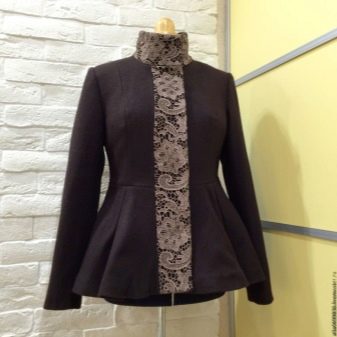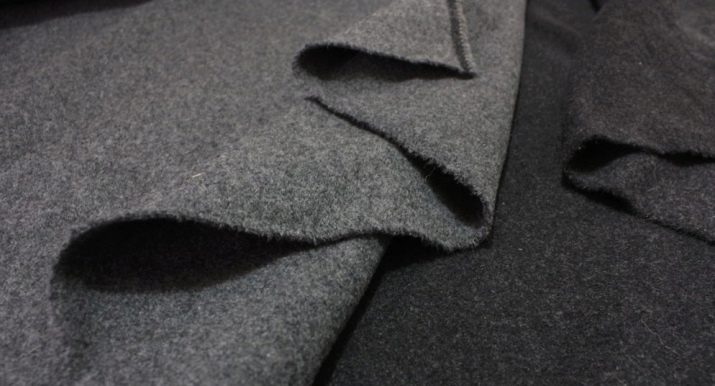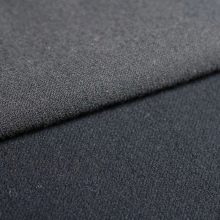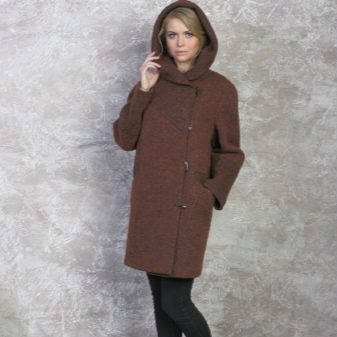What is drape and how is fabric applied?

Classics are always in demand. So they say about food, clothes, cars, music. But few people know that such an expression is applicable to tissues. Drape is considered the reference material in the garment industry for its functionality, comfort and quality. It is this fabric that is the basis for creating men's and women's wardrobes.


What it is?
According to the description, the drape cloth is characterized as a multilayer, compacted fabric with good thermal insulation and weather protection properties. High impermeability of the fabric is achieved by double or one-and-a-half connection of threads, which is created by machine pressing.
Drap is a weighted fabric, and therefore easily holds its shape. The figure of a person in such clothes is more slender, elegant, and the material itself does not wrinkle. The composition of the canvas is 100% wool, which means that clothes made of woolen fabric are always warm.
It is these properties that distinguish the matter under consideration from the coat.



The only drawback is one nuance: if the storage recommendations are not followed, creases are formed on the surface, which cannot be removed. But some users also note the high weight of the finished product on a natural basis, vulnerability to bad weather.
Natural fiber fabric does not stretch. Synthetic fabric has a slight stretch. Moreover, the more such threads in the composition, the more elastic the cut. Half-woolen fabrics keep their shape less.
When working with woolen cloth, it is worth listening to some advice.
- Before starting sewing, it is recommended to determine the direction of the pile. It is convenient to lay out paper patterns in one direction.
- The cut is pre-washed in lukewarm water to prevent shrinkage.
- Or the fabric is first ironed and then cut.


The basis of the fabric is a woolen thread. She varies in origin. Perhaps the most expensive and high quality thread is alpaca. In terms of thermal indicators, it is much ahead of sheep's wool. And camel's wool is resistant to moisture and moisture.
The percentage of woolen thread plays an important role in determining the quality.
Pure wool thread consists of 100% natural raw materials. There is no point in looking for the front or the wrong side - they are the same. Often, things made from natural linen are reworked.


70% of semi-woolen thread consists of natural raw materials, and the rest is synthetic additives. Such a canvas is characterized by friability, lightness, but the lowest heat indicators. Such properties are due to the content of viscose, nylon.
Products made from this material have many advantages:
- the ability to keep warm and comfortable;
- good breathability;
- does not absorb foreign odors;
- reliable protection from bad weather;
- durability and excellent wear resistance;
- versatility;
- elegance and style.


All production is fully automated.
Manufacturing technology is hardware spinning. Weaving, weft and warp are formed into two layers. In this case, the upper one consists of natural fibers, the lower one is made of synthetic or woolen threads.
The finished fabric fabric is formed under several types of press, after which the pile is removed on special machines. Sometimes the fabric is treated with certain compounds that maintain wrinkle resistance and moisture resistance.
In general, the manufacturing process looks like this:
- sorting of raw materials;
- combing with gimbal devices;
- spinning by means of mules;
- wallow;
- flushing, color, pile trimming, haircut;
- cleaning, pressing.


All production standards are stipulated in GOST 28000-2004. Characteristics by parameters here:
- GOST 30157.1-95 - parameters after dry cleaning;
- GOST 358-82 - characteristics of the variety;
- GOST 18117-80 - degree of wrinkling;
- GOST 9.055-75 - the possibility of damage by moths;
- GOST 9913-90 - degree of abrasion;
- GOST 3812-72 - density and sparseness of pile, threads;
- GOST 9733.4-83 - color fastness during washing;
- GOST 3816-81 - water-repellent characteristics, hygroscopicity.

History of appearance
On the territory of Russia, with the onset of the 15th century, the female part of the population weaved woolen cloth on hand-made looms. The opening of a cloth manufactory in Moscow dates back to the 17th century. It was then that wool spinning production began in Russia.
The first mention occurs at the end of the 18th century. Then, throughout Europe, and in France in particular, the entire industry developed rapidly, weaving equipment was born. Translated from French, drape is called cloth. At first, a voluminous, thick, durable wool cloth was made.
This activity quickly gained momentum. Manufacturers carried out experiments with color, pattern when weaving threads. Therefore, modern manufacturing is hundreds of non-repeating varieties of matter.
The current industry adds various synthetic fibers for elasticity, pliability, and the fabric base is made from reclaimed wool.


Species overview
Such a rather popular matter differs in its varieties.
By appointment
In this case, a female tissue with a lightweight structure stands out. Such cuts are subjected to additional processing: pressing, felting, combing. Velor, ratin, moth, castor, bottle are suitable for women's products. In other words, with a satin or twill weave. There is a matter of strict shades with a weighted structure, it is more dense, elastic. When sewing a men's collection, they often use a lint-free variety, as well as a thick-cloth two-layer one.Melange collections are made for wealthy men and women. As a rule, such products are expensive.


By composition
An elite grade is produced as a result of weaving a pair of fibers of a woolen thread without impurities. The result is a product with excellent wear resistance and preservation of its original appearance for a long time.
Pure wool warp should contain a maximum of 10% impurity threads. Sometimes yarns intertwined with unnatural fibers are added. The production is based on high-grade double-weave raw materials.
The release of the cheap category of fabrics is based on the use of low quality threads in the lower layer. The fabric is characterized by looseness and graininess on the seamy side. Experts note the low density of the fabric.


The semi-woolen fabric, in the lining layer of which is 75% wool, consists of polyester, nylon, viscose. The material is distinguished by its softness and looseness of the structure.
Synthetic upholstery is combined with artificial threads, polyester. Basically, it goes to the production of toys, souvenirs, workwear.
Melange is obtained from fibers of different colors, which creates a ripple effect. These are dense and thick rolls that look elite, expensive in cost. Moreover, the "herringbone" and "goose foot" have been popular with designers for quite a long time.


Pile processing makes its own adjustments. The classification is as follows:
- with a smooth, lint-free surface;
- with a high content of fluff on the front side due to the addition of goat hair - drape-moth;
- the ratin on the canvas has a diagonal arrangement of the pile with narrow threads;
- when forming an intricate pile, a bottle is obtained;
- when processing the surface with an automated method, weaving patterns are not visible, therefore, at the exit, you can get a velor drape with a high content of fluff from the wool of a thoroughbred sheep, a soft fleecy surface;
- wear-resistant dense cloth - castor;
with a high content of polyester - synthetic fabric.



By painting method
By staining, the following varieties are distinguished:
- variegated;
- one-color one-colored;
- melange with two or more shades.

By thickness
The thickness of the fabric can vary:
- outerwear for the spring-autumn period is sewn from a one and a half-layer piece with a density of 600 grams per square meter;
- the production of costume fabrics is carried out from a single-layer fabric with twill or satin weave threads with a density of 550 grams per square meter;
- warm winter products are sewn from two-layer fabric with a density of up to 700 grams per square meter.



Application
A huge number of various clothes are sewn from woolen fabric: coats, hats, hats, scarves, caps, ponchos, trimmings for bags, shoes, and other accessories. Suit fabric is used in the manufacture of many types of clothing. Cloths made of unnatural fabrics are suitable for sewing uniforms and equipment from the weather.
The fabric is comfortable to work with. The edges will not crumble during sewing.
Toys, accessories, decor are made from woolen fabric. Designers use drape when decorating the interior, manufacturing and covering furniture, sewing complex covers.
Also, drape fabric goes well with many types of fabrics, styles. At the same time, bright, original images are obtained. The drape is easy to combine with thin flowing fabrics, lightweight knitwear, leather, duspo, corduroy, bouclé. Outerwear trimmed with fur looks gorgeous.



Matter is so versatile that it allows you to do incredible things. For example, you can create attractive folds on an Angelica or shawl collar. A drape coat with a belt looks universally. Outerwear with cascading drapery at the lapels came into vogue. It is easy to combine such products with various accessories.
It is not only a versatile but also a fashionable fabric base. It is combined with products of different styles:
- grunge;
- classic;
- eclecticism;
- casual;
- military;
- romance.



Care rules
Products made from natural fabric do not require particularly complex maintenance. Dry cleaning of things is mainly used. Usually, outerwear is cleaned once every six months. Washing of such wardrobe items is prohibited, it is recommended to send complex products to dry cleaning.
Often animals live next to a person, which can leave wool behind on draped clothes. It is removed from the surface of the products with a soft bristle brush.
A similar accessory and soap solution are used for removing stains.
You need to apply the foam in small portions, it is better to remove the excess with a soft sponge.


Lightweight clothing is allowed to be hand washed, but with care: at a temperature of 30 degrees, using powder, without using bleach. Moreover, the combination with other products is prohibited. It is not recommended to wring out, twist or rub things during washing. After rinsing, the clothes are straightened on a flat horizontal surface for draining. It should be borne in mind that drying is shown in the shade, ventilated area.
You can iron with an iron, but on a gentle mode and using wet gauze or a steamer.
They store clothes, as a rule, on a hanger, in a cover.
If during a walk the coat gets wet in the rain or snow, then at home it must be hung on a hanger and sent to a warm place, allowed to dry thoroughly.

There is a huge assortment of this kind of products in modern stores. It is difficult for a beginner to navigate the range. But you need to understand that the fabric is different in properties, method of application. Therefore, before buying, you need to decide for what purposes the cut will be used. For demi-season things, you need good thermal insulation. For winter, it is recommended to purchase options with a higher thread density, good wind resistance. When sewing raincoats, anthers, it is worth considering the water-repellent property of woolen cloth.
As for the finished item, you need to pay attention to the composition, structure, relief, weight. For example, the first two parameters can be learned from the label. Natural canvas differs in weight, has a complex weave of fibers.
Drap is a versatile, easy-to-use fabric. A huge number of products are sewn from it, it is convenient to wear it, decorate rooms, make jewelry, toys. During use, it is necessary to remember the rules of fabric care, because it is in this case that the product will delight the eye for a long time.










